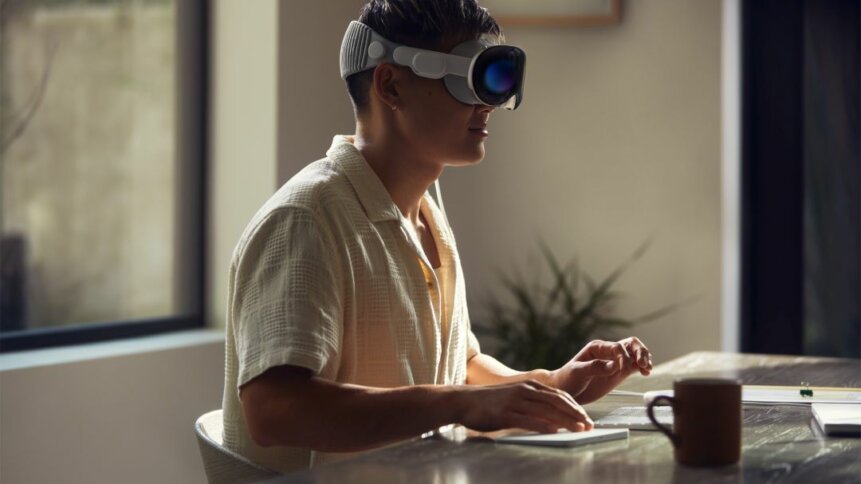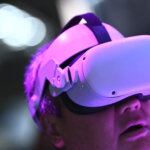Apple’s Vision Pro will appeal to industrial mixed reality market

Apple’s unveiling of its Vision Pro mixed reality headset at WWDC 23 – broadcast from the computing firm’s Apple Park campus in Cupertino, California, US – put an end to speculation on the device’s design. And one of the biggest clues to the future of wearable computing is the fact that the Vision Pro is bristling with electronics linking users with their surroundings.
Apple describes the interactive elements as a sophisticated array of cameras and sensors. But TechCrunch’s Kyle Wiggers adds a few more details and notes that the design integrates internal eye-tracking infrared cameras, as well as downward-facing optics to track the wearer’s hands. And looking outwards from the Vision Pro are LiDAR sensors, which produce a point map of the mixed reality headset’s real-world surroundings.
Additionally, there are external high-definition cameras to feed through crisp visuals from the outside as required. And it’s being able to tie together the real and the unreal – actual images of the physical environment with digital views displayed internally – that will make the device feels so immersive. Designs that omit those external cues blindfold users and risk an experience that fails to catch on.
Apple’s developers have configured the setup to enable – in their words – an era of spatial computing. And video demonstrations of the unit show users navigating familiar iOS apps with their eyes, hands, and voice. But opportunities for the wearable computer, which features the firm’s M2 processor (found in Mac laptops and desktops) as well as a mixed reality specific R1 chip to accelerate the management of sensor data, go beyond creating a visual operating system.
Readymade mixed reality platform
The Vision Pro mixed reality headset could provide a readymade platform for industrial users to educate operators on how to use all kinds of equipment by blending real-world controls and digital visuals. When TechHQ spoke with Ryan Binns, Chief Architect at BISim in September 2022, he emphasized how real-world video combined with eye-tracked, high-resolution digital imagery provides an immersive training environment for rescue crews, forest fire fighters, logistics teams, and other workers.
Seeing your own hands on physical actuators that are exactly the same as those found on site, while having video feeds swapped into the image and displayed in front of your eyes makes for a memorable and highly-realistic experience. “Your brain goes with it because everything feels right,” Binns told TechHQ.
Addressing an industrial audience could help Apple solve one of the potential barriers to the success of its Vision Pro headset – cost. According to the firm, the mixed reality product will retail starting at US $3,499. And that’s a high price for many regular tech consumers to pay. For comparison, Meta’s Quest 3 – the latest iteration of its SnapDragon-powered virtual and mixed reality headset – will cost US $499 when it hits the shelves later this year.
VR headsets have never been cheap to produce. Contributing to the high cost is the fact that displays need to be extremely high resolution as they sit much closer to users’ eyes. If developers use regular screens, similar to those found in smartphones or laptops, headset wearers may be able to discern individual pixels, which would ruin the immersive nature of the experience.
According to Apple, the two postage-stamp-sized high-definition OLED displays used inside the Vision Pro are, in effect, miniature 4K TV displays – one for each eye. In the same space occupied by a single iPhone pixel, designers have packed 64 pixels to provide headset wearers with a view comparable to looking at images on a modern smartphone.
And while regular tech consumers may balk at the device cost, for companies, the mixed reality technology could represent a budget-friendly investment. A digital – but highly memorable and realistic – experience that saves days of difficult and expensive to arrange industrial training would quickly justify the price of Apple’s hardware.
Skill sharpening tool
You can picture all kinds of scenarios where having spent time on a simulator, enabled using mixed reality tools, is likely to accelerate learning when it comes to getting hands-on, practical experience. Users can make mistakes digitally to avoid the same errors when operating in the real world. And it doesn’t take a huge leap of the imagination to see how virtual reality headsets could benefit education in medicine, healthcare, and other fields where lives are at stake.
The technology could also enable a much richer remote learning experience and help professionals to share their knowledge with colleagues without having to be in the same room, or even country. Again, the financial rewards for companies would soon add up, easily justifying the cost of the mixed reality hardware by saving on flights, hotels, truck rolls, engineers’ time, and other expenses.
Apple’s world-class marketing team will do its best to make the Vision Pro appeal to the tech giant’s consumer audience, including cross-over opportunities in workplace settings. But the strongest proposition for the immersive mixed reality headset, given the high cost of the equipment, could turn out to be as an industrial tool. And simulation developers will no doubt be keen to get their hands on systems to start putting the technology to the test.









